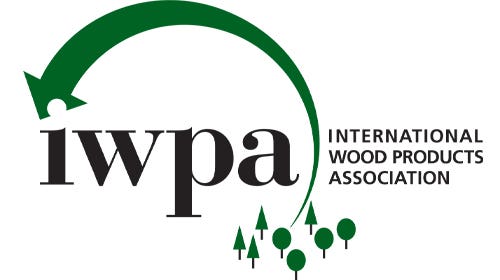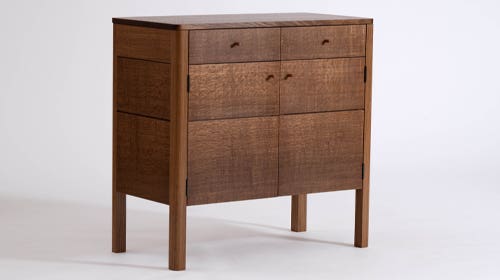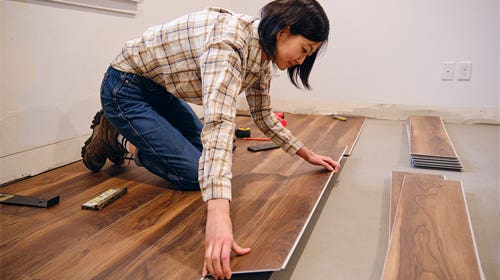Figured bubinga slabs remain plentiful
Bubinga is one of the African woods that remains in good supply, often has an attractive figure and is reasonably priced. Although several factors such as the falling dollar and…
Bubinga is one of the African woods that remains in good supply, often has an attractive figure and is reasonably priced. Although several factors such as the falling dollar and increased freight costs have driven the cost of bubinga up in the last few years, lumber and slabs can still be purchased at a moderate price.
The cost of bubinga is wide-ranging, so it behooves the buyer to shop around and take a close look at the inventories and pricing of various exotic dealers. Figured slabs are priced from as low as $10/bf to as high as $85/bf usually — but not always — based on the amount of the figure. The disparity in pricing equates to a tremendous cost differential when purchasing large slabs that contain more than 100 bf.
“The main inflation in price comes from the poor dollar,” says Myles Gilmer of Gilmer Wood Co. in Portland, Ore. “That almost entirely takes care of it. Just a few years ago, I could probably buy it [wholesale] for $3 to $3.50/bf. Now it’s probably $4.50 to $5.50/bf, unless it is tremendously figured. I just sold some heavily figured 6/4 to 8/4 slabs for table tops for about $24/bf. I think most of the other people involved in the bigger slabs are [selling it for] $35 to $80/bf.”
“Bubinga prices are steadily on the rise, just like wenge,” says Matt Westmoreland of World Timber Corp. in Hubert, N.C. “Availability wise, I have no problem and I still get monstrous boards, whether it’s an order of 4/4, 6/4 and 8/4, we’re getting big tabletop flitches. I’ve got some boards that are 5' wide and 15' long. Those boards obviously come with a premium. I think we sell them for about $25/bf wholesale and you probably get about 125 bf in one slab, so they get up to $3,000 or $4,000. That’s a medium figure.”
Bubinga (Guibourtia tessmannii) is also known as African rosewood. Trees grow in excess of 140' with huge trunk diameters. Productive trees are free of branches up to 60'. Bubinga’s heartwood is reddish-brown with pink or red striping. Its sapwood is an unattractive creamy white.
“It’s actually a pretty decent rosewood substitute,” says Gilmer. “It’s quite a nice wood. It’s stable, machines pretty well, and takes a beautiful polish. It’s hard — compression resistant — so it’s good for table tops and things like that because you can drop stuff on it without beating the hell out of it.”
Bubinga’s uses include furniture, flooring and veneer. Bubinga can exhibit several figures, including pommele, quilted, curly, mottled and waterfall. Many of the highly figured logs that were previously being set aside for veneer are now being purchased for slabs.
“The boards that are selling, people like the figure, the pommele or curl or ribbon,” says Kent Mace of Collective Specialty Hardwoods of Gardner, Colo. “That dark, rich color seems to be a color the interior decorators like and the clients are agreeing with them. Despite the higher costs, the market is protected. The folks that can afford one of these great big planks; the cost doesn’t affect them that much.”
Gilmer noted that since bubinga usually grows alone or in very small groups, there may be a supply problem looming. A larger factor may be that Cameroon, the largest supplier of bubinga, recently banned the export of logs to large mills in Europe.
“There’s almost nothing coming from Cameroon,” explains Gilmer. “All their big stuff came from the northeast part of the country and it’s been heavily logged for probably 80 years. I think the Cameroonians were just tired of seeing their forests shot out of the country at $50/ton, or something like that. They want to see some value added. So everything you see, the big table slabs, is all from Gabon. The supply is still pretty good; it’s just a little different material.”
Bubinga is also sold as a tonewood for acoustic guitar backs and sides.
“We always try to buy figured stock, which is fairly common in bubinga,” says Bill Hibdon of Hibdon Hardwoods in St. Louis. “I would say it’s in the upper echelon of tonewoods. It’s not as good as African blackwood or Honduras rosewood, but it’s on a par with Indian rosewood. It’s not the best, but it’s not bad. It depends on the figure, but a nicely figured bubinga back and side set would probably go for $150 to $175.”
Bubinga has tremendous working properties, even though it is hard, heavy and dense. It has an average density of .72. Bubinga dries slowly, but without much distortion. It is fine-textured and accepts stain well and takes a fine finish. Cutting edges must be kept extremely sharp and hand-planing figured stock is difficult, but using a scraper is fine.
“Bubinga comes big, real big. It’s one of the most popular woods that we sell,” adds Westmoreland.
Retail prices for kiln-dried 4/4 plain bubinga ranged between $7/bf and $12/bf. Square-edged boards with a little bit of figure were priced between $14/bf and $20/bf. The cost of moderately figured bubinga started at $22/bf and some huge slabs were being sold at nearly four times that price.
This article originally appeared in the October 2008 issue.







